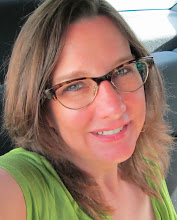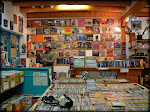When I told people I was going to see Bob Dylan live, I got a variety of responses, almost none of them
positive.
"Is he still alive?" was the common refrain from those under 45. Those older could often vividly recall being dragged to a show sometime in the mid-70s or late 80s. "That was the worst show I've ever been to in my life." With all this lackluster response, you'd think I'd be thwarted.
But no.
My goal here is not to spout the merits of Dylan's significance or convince you to like him. Admittedly, my interest came seemingly out of nowhere, and I thought I had set up pretty solid
resistances.
My first real exposure to Bob Dylan was in the summer of 1994. I'd just returned home from living in Rochester, NY for a year. On one of my first nights back, I went out and met Peter, a fun, interesting, cute computer programmer/music enthusiast. We started dating and we were often at his place (I was living with my folks at the time.) Peter had great tastes in music and the stereo played all of the time - Van Morrison, Peter Gabriel, the newly released Counting Crows "August and Everything After", even some classic Journey. The only thing I had a hard time taking was some of the Tom Waits (although I could be easily swayed with the songs that i
ncorporated carnival sounds) and the Dylan.
I just couldn't take the voice.
I don't remember what Peter might have said to try to convince me, but I wasn't having it. However, he did insist I go with him when Dylan played at the Ohio State Fair later that summer. I'd talked about taking Peter to the Fair since I'd met him (he was from Chicago and never been to any county or state fair and I was looking forward to being his guide.) The Dylan show at the end of the day was the compromise.
The fact that he was actually playing the Ohio State Fair was evidence enough for me of his lack of importance. There were only two reasons to play such a venue - you're either on your way up, or down. But we went, and I can remember being really impressed with the band. And the songs. I walked out, not converted, but impressed that I didn't hate the experience.
Three years later, I met and started dating Rob. He, too, had great tastes and played music constantly. But so did I. By this point, I was living in an apartment and the
unspoken rule was
whomever's place we were in got to decide the music, and I was a little more tolerant of being exposed to things outside of my realm, as long as it wasn't forced upon me.
"Time Out of Mind" came out around that time. It was in heavy rotation at Rob's, but I still didn't pay close attention. Over the next decade, as Rob and I would drift in and out of each other's lives, I noticed that Dylan remained a constant staple at his house. When I expressed my opposition, saying that being a bad singer when you were a
singer was pretty big barrier, he said, "His voice is really not the point."
That didn't really go over very well and I refused to listen to any more for several years.
What did it for me was, not
surprisingly, a movie. In 2007, Todd Haynes released "I'm Not There", an unconventional Dylan bio-pic that wooed the critics but
confused regular audiences.
I've read a lot of interviews and was intrigued. Instead of the traditional linear approach of following a life, Haynes
chooses to assign six different "
personas" to define Dylan - the
impostor, the earnest
folkie, the superstar, the family man, the poet, and the recluse.
This, I thought, is the future of narrative film.
From there, I started exploring Dylan's various "phases" and found myself more interested in the lesser-known stuff than the classics (not because I think they're better, but more because pop culture tends to over-saturate its heroes.) Then I picked up an audio-book version of "Chronicles," Dylan's long-awaited autobiography and was impressed by his constant struggle to remain true to his direction and expression. There has never been a time when this man has not produced the kind of work he wants to, with limited outside influence. Turns out he
wants to play places like the Ohio State Fair and the Canton Civic Center. Some artists say that because they have no other choice. I think if someone like Bob Dylan wanted to regularly sell out arena
venues, I'm sure some executive at Frito-Lay could make that happen.
Over the past year, I've added albums from his back-up-singer infused seventies period as well as the vastly under-rated Born Again records. Still, I will admit some of my favorite renditions are covers by other artists, but I'm gradually developing some immunities.
So I was looking forward to the opportunity to re-examine my Dylan live-show experience with all of this new-found fan status under my belt. The fact that I was able to enjoy one show with Allen, a former co-worker and long-time Dylan enthusiast, and the second with Rob, with whom I've been enjoying a recent, renewed relationship, was a real treat.
I'm not much of a concert reviewer. I will say, however, that it was, again, the band and the music that stirred me. Dylan is now old enough that his voice (once described by
Bono as a dirt bowl yelp, bluesy street howl) has deepened into a tolerable, gravely monotone that almost functions like a harmonium.
And just when I thought I was immune to the over-played older stuff, I was caught up, just like a 1960's London teenager, in the exuberance that is "Like a Rolling Stone," Singing along, hands cupped around my mouth for effect, in an exaggerated declaration of long-
vowel sounds:
How does it feeeeeeeeeeeeelHow does it feeeeeeeeeeeeeeeeeeeeelTo be on your oooooooooownWith no direction hooooooooooooomeLike a complete unknooooooooownLike a rolling stoooooone








